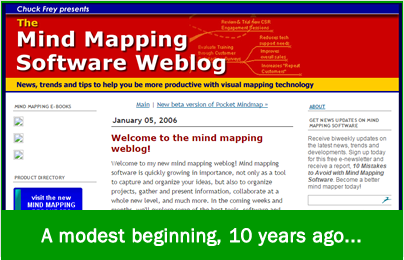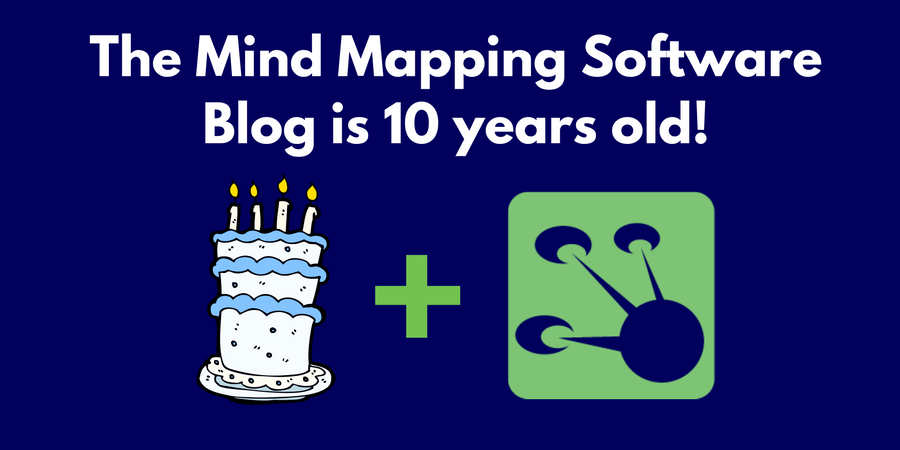I spend so much time in heads-down mode, producing content for this blog or generating fresh ideas for it that I don’t pay much attention to the passing of time. A case in point: Liam Hughes and his team at Biggerplate.com recently figured out that the Mind Mapping Software Blog is celebrating its 10th anniversary this year!
Thanks for your enthusiastic support of my efforts to share news, tips, reviews and trends with you. I couldn’t do this without you!
 Here’s just a bit of backstory on how this blog came to be:
Here’s just a bit of backstory on how this blog came to be:
In the early 2000s, I was covering mind mapping software as part of a much larger website, InnovationTools.com. It focused on tools and strategies to help innovators be successful. As I watched the market grow, I soon realized that this genre of software needed a blog that would focus solely upon it.
At the time, a number of blogs covered mind mapping software as part of a larger collection of topics. But I recognized that business people needed help understanding what mind mapping software was and what it was capable of. So I created the first blog on the world dedicated to it.
A lot has happened in the last 10 years. Here’s an overview of the evolution I’ve seen in this type of software:
1. Greater integration with business applications
Ten years ago, the export capabilities of mind mapping programs were fairly simple. They provided users with the ability to export mind maps to Microsoft Word and PowerPoint, plus as an image. Today, mind mapping programs enable you to export and import in a variety of formats. The Rosetta Stones for transferring data between mind mapping tools are MindManager’s .MMAP format and Freemind, an open source mind mapping program.
2. Web-based applications are now on a par with desktop programs
The user interfaces of web-based mind mapping applications ten years ago were simplistic. Now that the major apps have been rebuilt using HTML 5 standards, the experience of using them is on a par with the best desktop mind mapping experiences.
3. Mobile mind mapping apps come of age
Mind mapping apps have grown like topsy during the last 10 years on both tablet and smartphone platforms. But most smartphones (and phablets) don’t have big enough screens to be practical for this application. On a tablet, however, it’s a different story. There are many mind mapping apps for the iPad. The best among them enable you to export your maps to popular mind map formats. That enables them to support this usage scenario:
- Capture your ideas on the iPad in a mind map.
- Export it to a popular mind map format.
- Import it into a desktop mind mapping program for further development.
4. Greater emphasis on collaboration
10 years ago, you either had a licensed desktop mapping program or you had nothing. There were no other options. Today, several high-end mind mapping programs integrate with Sharepoint or other web-based task management programs, enabling team members to either participate in team projects via a connected web-based app or the task management tools they use can do two-way updates with the desktop tools. In other words, more team members can participate at a lower cost per seat than ever before.
Today, a number of higher-end mind mapping software programs are connected to proprietary web-based platforms for map and file sharing, along with companion web-based mind mapping apps. You can save files directly to your cloud account from these programs.
5. More options for mind map templates
 Ten years ago, the only mind map templates these programs could access were those it installed on your computer’s hard drive. Today, a growing number of desktop programs can connect with Biggerplate.com, the world’s largest repository of software-produced mind maps. These programs can “talk to” Biggerplate, enabling you to search for mind maps you can download and adapt to your needs.
Ten years ago, the only mind map templates these programs could access were those it installed on your computer’s hard drive. Today, a growing number of desktop programs can connect with Biggerplate.com, the world’s largest repository of software-produced mind maps. These programs can “talk to” Biggerplate, enabling you to search for mind maps you can download and adapt to your needs.
Biggerplate.com is now integrated with these mind mapping tools:
- iMindMap
- MindManager
- MindMeister
- XMind
- iThoughts
- MindGenius
- ConceptDraw MINDMAP
- FreeMind
- MindMapper
- iMindQ
What’s next?
Integration between mind mapping software programs and web services is a big growth area, especially with the emergence of services like Zapier.com and IFTTT (If This, Then That). These apps act like a digital Rosetta Stone, translating requests from one application to another, and acting as “middleware” so data can move smoothly between them. MindManager 2017 recently launched with support for Zapier, which enables it to “talk” to a variety of web-based task management applications, for example.
Now I’d like to hear YOUR opinion. What do you think is on the horizon for mind mapping software? Please share your ideas in the comments area below. Thank you!


Leave a Reply